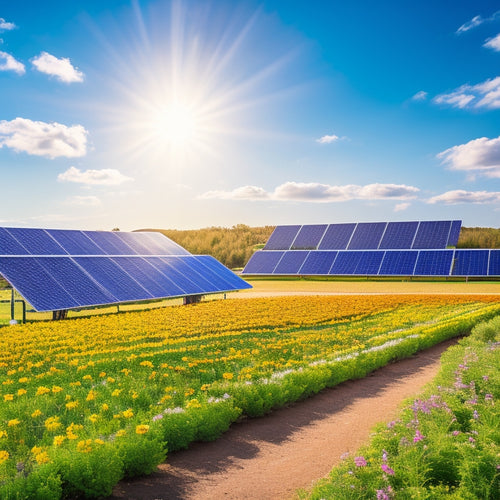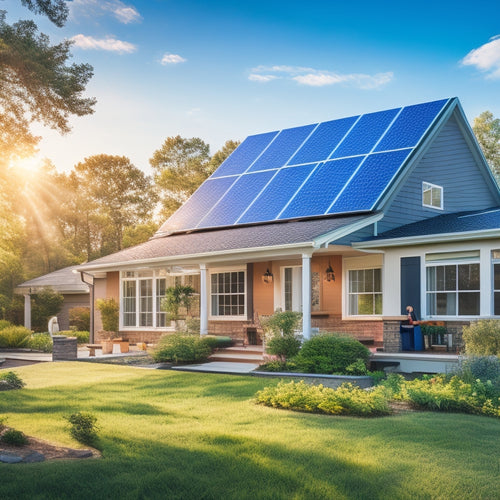Monitoring Sustainability: The Intersection of Technology and Eco-Friendly Practices
Share
As you navigate the complex landscape of environmental sustainability, you're likely to find that innovative technologies are increasingly instrumental in driving eco-friendly practices. From monitoring greenhouse gas emissions to optimizing energy efficiency, digital tools are revolutionizing the way we approach sustainability. But how do these technologies intersect with eco-friendly practices, and what are the implications for organizations seeking to reduce their carbon footprint? As you explore the intersection of technology and sustainability, you'll discover the transformative power of data analytics, IoT sensors, and digital tools in shaping a more sustainable future - and you're about to uncover the cutting-edge strategies that are leading the way.
Key Takeaways
• Implementing environmental monitoring technologies, such as satellite imaging and IoT sensors, enables real-time tracking of environmental changes and pollution.
• Data analytics and digital tools facilitate data-driven decision-making, helping organizations develop and track sustainable practices and measure their environmental impact.
• Cybersecurity protocols, like encryption, are crucial for protecting sensitive environmental data from cyber threats and maintaining data integrity.
• IoT sensors and energy-efficient technologies can reduce energy consumption by up to 30% and optimize resource management, minimizing waste and carbon footprint.
• Regular tracking and disclosure of greenhouse gas emissions and supply chain sustainability metrics promote transparency and accountability in eco-friendly practices.
Technology for Environmental Monitoring
Satellite imaging and sensor technologies have enabled you to monitor environmental changes with unprecedented accuracy, allowing for real-time tracking of deforestation, ocean pollution, and climate shifts.
This heightened level of surveillance has been further amplified by the deployment of environmental drones, which provide high-resolution aerial imagery and real-time data on environmental health.
However, as your reliance on these technologies grows, so do the cybersecurity risks. You must remain vigilant in protecting sensitive environmental data from potential breaches, ensuring that your monitoring efforts aren't compromised by malicious actors.
Implementing robust cybersecurity protocols, such as encryption and secure data storage, is essential to maintaining the integrity of your environmental monitoring operations. By doing so, you can guarantee that your efforts to track environmental changes remain effective and reliable, ultimately informing data-driven decisions that drive sustainable practices.
Data Analytics for Sustainability
As you explore data analytics for sustainability, you'll discover the power of data-driven decision making. By leveraging advanced analytics, you can uncover hidden patterns and correlations that inform your eco-friendly strategies.
With real-time performance tracking, you'll be able to optimize your sustainability efforts and make data-backed decisions that drive meaningful change.
Data-Driven Decision Making
By harnessing advanced data analytics, you can reveal critical insights that inform sustainable practices and drive environmentally conscious decision-making across your organization. This enables you to make data-driven decisions that prioritize corporate accountability and reduce your organization's ecological footprint.
To achieve this, you'll need to develop digital literacy within your organization.
-
Integrating data analytics tools into your existing systems to collect and analyze environmental performance data.
-
Developing key performance indicators (KPIs) to measure and track sustainability metrics, such as energy consumption, water usage, and waste reduction.
-
Creating data visualization dashboards to communicate complex data insights to stakeholders, facilitating informed decision-making and driving accountability.
Real-Time Performance Tracking
With data analytics, you can now monitor your organization's environmental performance in real-time, allowing you to respond promptly to deviations from sustainable targets. This enables you to track your performance metrics and make adjustments as needed to stay on track.
Real-time performance tracking is essential for tracking accountability and identifying areas for improvement. By leveraging data analytics, you can:
| Metric | Target | Current Status |
| Water Consumption | 10% reduction | 8% reduction |
| Carbon Emissions | 15% reduction | 12% reduction |
| Waste Management | 20% reduction | 18% reduction |
IoT Sensors in Eco-Friendly Practices
As you explore the role of IoT sensors in eco-friendly practices, you'll discover their potential to transform various aspects of sustainability.
IoT sensors can be deployed to monitor and optimize energy efficiency, track air quality, and streamline waste management systems.
Air Quality Monitoring
You can utilize IoT sensors to continuously track and analyze air quality, enabling real-time monitoring of pollutants like particulate matter, nitrogen dioxide, and ozone. This technology is essential in creating Clean Cities, where citizens can breathe easily without the threat of Toxic Exposure.
By leveraging IoT sensors, you can:
-
Identify pollution hotspots: Pinpoint areas with high concentrations of pollutants, enabling targeted interventions to reduce emissions.
-
Monitor emissions in real-time: Receive instant alerts when pollutant levels exceed safe thresholds, allowing for swift corrective actions.
-
Optimize urban planning: Use data-driven insights to design more efficient, eco-friendly cities, minimizing air pollution and promoting sustainable development.
Energy Efficiency Tracking
IoT sensors can track energy consumption patterns in real-time, empowering you to optimize energy usage and reduce waste in commercial and residential buildings. By leveraging IoT sensors, you can identify areas of importance and take corrective action to minimize energy waste.
For instance, smart plugs can provide detailed data on energy consumption, enabling you to pinpoint devices or appliances that are guzzling energy. This data-driven approach allows you to make informed decisions about energy efficiency, reducing your carbon footprint and saving on energy costs.
Conducting regular energy audits is also essential in identifying opportunities for energy efficiency improvements. IoT sensors can facilitate this process by providing real-time data on energy consumption patterns, helping you identify areas of importance and prioritize energy-saving initiatives.
Waste Management Optimization
Effective waste management relies on accurate monitoring and analysis of waste generation patterns, which IoT sensors can facilitate by capturing granular data on waste streams and recycling rates. You can leverage this data to identify areas of improvement in your waste management strategy, reducing waste disposal costs and environmental impact.
To optimize waste management, you can:
-
Conduct waste auditing: Analyze waste generation patterns to identify opportunities for reduction, reuse, and recycling.
-
Monitor material flow: Track the movement of materials throughout your operations to identify inefficiencies and areas for improvement.
-
Implement smart waste collection: Use IoT sensors to optimize waste collection routes and schedules, reducing fuel consumption and lowering emissions.
Digital Tools for Eco-Impact Assessment
Companies can harness digital tools to quantify their environmental footprint and identify areas for improvement, facilitating data-driven decisions that drive sustainability. You can utilize digital platforms to monitor and analyze your carbon footprint, enabling you to pinpoint high-impact areas and develop targeted reduction strategies. By leveraging stakeholder engagement tools, you can foster open communication with investors, customers, and employees, ensuring that your sustainability efforts align with their values and concerns.
Digital tools can also help you streamline data collection, enabling you to track key performance indicators (KPIs) and measure progress toward your sustainability goals. This data-driven approach allows you to refine your strategies, optimize resource allocation, and make informed decisions that drive business growth while minimizing environmental impact.
Sustainable Resource Management Strategies
As you implement sustainable resource management strategies, you'll want to focus on optimizing supply chains to reduce waste and minimize environmental impact.
By streamlining logistics and transportation, you can greatly decrease your carbon footprint.
Additionally, conserving natural resources through efficient resource allocation and reduced consumption will be key to achieving your sustainability goals.
Optimizing Supply Chains
By streamlining logistics, you can reduce transportation-related emissions and cut supply chain costs by up to 10%, according to a study by the World Economic Forum. This is essential, as supply chains are a significant contributor to greenhouse gas emissions.
To optimize your supply chain, focus on the following strategies:
-
Carbon footprinting: Calculate and analyze your supply chain's carbon footprint to identify areas for improvement.
-
Logistics synchronization: Optimize routes, modes of transportation, and warehouse operations to reduce fuel consumption and lower emissions.
-
Real-time monitoring: Leverage IoT sensors, GPS tracking, and data analytics to monitor your supply chain in real-time, enabling swift responses to disruptions and inefficiencies.
Conserving Natural Resources
To reduce your organization's environmental impact, you must implement sustainable resource management strategies that prioritize conserving natural resources. The extraction, processing, and distribution of raw materials contribute substantially to greenhouse gas emissions. By adopting a conservation-focused approach, you can minimize waste, reduce your carbon footprint, and guarantee long-term sustainability.
Implementing water harvesting systems, for instance, can greatly decrease your organization's water consumption. This can be achieved through rainwater collection systems, greywater reuse, and efficient irrigation systems.
Additionally, land preservation strategies can help protect biodiversity, prevent soil erosion, and maintain ecosystem services.
Greenhouse Gas Emissions Tracking
You can accurately measure and track your organization's greenhouse gas emissions using standardized protocols and digital tools that provide real-time data and analytics. This enables you to identify areas of improvement and implement strategies for emissions reduction, ultimately reducing your carbon footprint.
To effectively track greenhouse gas emissions, consider the following key steps:
-
Conduct a thorough emissions assessment: Establish a detailed emissions inventory to understand your organization's current emissions profile.
-
Set emissions reduction targets: Develop science-based targets aligned with global climate goals to guide your emissions reduction efforts.
-
Monitor and report progress: Regularly track and disclose emissions data to stakeholders, ensuring transparency and accountability.
Energy Efficiency Optimization Methods
Implementing energy-efficient technologies and practices can help your organization reduce energy consumption by up to 30%, resulting in significant cost savings and emissions reductions. By leveraging advanced technologies, you can optimize energy usage and minimize waste.
To achieve energy efficiency, consider the following strategies:
| Method | Description |
|---|---|
| Smart Grids | Integrate advanced technologies, such as IoT sensors and AI, to optimize energy distribution and consumption |
| Green Buildings | Incorporate energy-efficient design, materials, and systems to reduce energy consumption |
| Energy Management Systems | Implement software to monitor and control energy usage in real-time |
| LED Lighting | Replace traditional lighting with energy-efficient LED options |
| Building Automation | Integrate automated systems to optimize energy usage and reduce waste |
Waste Reduction and Recycling Tech
By reducing waste and integrating recycling technologies, organizations can minimize their environmental footprint and access significant cost savings. You can take a proactive approach to waste reduction by implementing innovative recycling solutions that maximize resource efficiency.
Here are three ways to optimize waste reduction and recycling tech:
-
Composting Initiatives: Implement on-site composting programs to divert organic waste from landfills, reducing greenhouse gas emissions and generating nutrient-rich soil amendments.
-
Recycling Education: Educate employees and customers on proper recycling practices, increasing recycling rates and reducing contamination.
-
Advanced Recycling Technologies: Leverage AI-powered sorting machines and robotics to enhance recycling efficiency, accuracy, and profitability.
Supply Chain Sustainability Monitoring
What specific metrics and key performance indicators (KPIs) does your organization track to maintain supply chain sustainability, and how do you leverage data analytics to identify areas for improvement?
Effective supply chain sustainability monitoring relies on the collection and analysis of accurate data. You should track metrics such as carbon footprint, water usage, and waste reduction to gauge your organization's environmental impact. Additionally, monitoring social metrics like labor practices, health, and safety guarantees that your supply chain is socially responsible.
Data analytics plays an essential role in identifying areas for improvement and mitigating risks. By leveraging advanced analytics tools, you can pinpoint potential risks and opportunities for improvement, enabling proactive Risk Management strategies.
Moreover, engaging with stakeholders through transparent reporting and regular updates ensures that your organization remains accountable and responsive to their concerns. Stakeholder Engagement is critical in building trust and credibility in your organization's commitment to sustainability. By integrating data-driven insights and stakeholder feedback, you can refine your supply chain sustainability strategy and drive meaningful change.
Emerging Trends in Eco-Tech Innovation
As you explore the intersection of technology and sustainability, you'll find that emerging eco-tech innovations are revolutionizing the way businesses mitigate their environmental footprint. These innovations are transforming the way companies approach sustainability, from reducing waste to promoting a circular economy.
Here are three key trends shaping the future of eco-tech innovation:
-
Circular Economy Platforms: Tech-enabled platforms are emerging to facilitate the sharing, reuse, and recycling of products, reducing waste and promoting a closed-loop economy.
-
Green Crowdsourcing: Crowdsourcing platforms are being used to mobilize communities and individuals to contribute to environmental projects, such as clean-ups and conservation efforts.
-
AI-Powered Sustainability Analytics: Advanced analytics and AI are being used to monitor and optimize sustainability performance, enabling companies to make data-driven decisions and drive meaningful environmental impact.
These innovations are driving a new era of eco-tech innovation, empowering businesses to take bold action on sustainability and create a more environmentally conscious future.
Frequently Asked Questions
What Is the Most Effective Way to Measure Sustainability Progress Over Time?
As you track sustainability progress over time, you'll find that data analysis is key; regularly conduct environmental audits, assess impact, and establish clear sustainability metrics to accurately measure progress, ensuring informed decisions and effective progress tracking.
How Can Small Businesses Afford Sustainable Technology and Practices?
You can afford sustainable technology and practices by implementing budget strategies like cost-benefit analysis and ROI tracking, and exploring green financing options like green bonds, grants, and tax incentives to offset costs.
What Are the Primary Benefits of Using Iot Sensors in Eco-Friendly Practices?
You'll gain precise real-time monitoring and optimization capabilities with IoT sensors, driving energy efficiency and reducing waste, resulting in significant cost savings and a minimized environmental footprint.
Can Digital Tools Accurately Measure Environmental Impact and Sustainability?
You'll find that digital tools can accurately measure environmental impact and sustainability, but only if you prioritize high-quality data and implement human oversight to validate results, ensuring reliable insights that inform effective eco-friendly strategies.
Are There Any Government Incentives for Adopting Sustainable Technologies?
You can capitalize on government incentives, such as Tax Credits and Green Grants, to offset the costs of adopting sustainable technologies, leveraging financial benefits to drive eco-friendly practices within your organization.
Related Posts
-

Innovative Sustainable Materials for Energy-Efficient Homes
Innovative sustainable materials enable you to create energy-efficient homes while promoting environmental responsibi...
-

High-Performance Solar Solutions for Sustainable Living
High-performance solar solutions are your gateway to sustainable living, maximizing energy efficiency while considera...
-

Solar Energy Grants and Incentives for Homeowners
Maneuvering solar energy grants and incentives is essential for reducing your installation costs. You can benefit fro...


